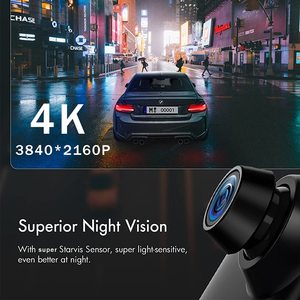(69851 products available)




























































































































































































































An in-car mirror DVR is a device that combines a traditional rearview mirror with a built-in digital video recorder (DVR) and, in many cases, a display screen. This technology is designed to enhance vehicular safety and convenience. The in-car mirror DVR is becoming popular for its multifunctional capabilities, which may include GPS navigation, Bluetooth connectivity for hands-free calling, voice control, and even smartphone integration for accessing apps and navigation.
There are several types of in-car mirror DVRs available.
Rearview mirror backup cameras
Backup cameras have become standard in most new cars. They show a video feed of what's behind the vehicle on a screen integrated into the rearview mirror. This feature helps avoid accidents during reversing by providing a clear view of the back area.
Auto-dimming rearview mirrors
Auto-dimming rearview mirrors reduce glare from the headlights of vehicles behind you. They have built-in sensors that detect light levels. When brighter light levels are detected, the mirror's surface changes to a darker tint, reducing glare for drivers.
Smart rearview mirrors
Smart rearview mirrors integrate with smartphones, displaying navigation, calls, and messages. Some even have voice control, allowing drivers to manage the mirror's features without taking their hands off the wheel or their eyes off the road.
Rearview mirrors with homelink
HomeLink rearview mirrors can connect to devices like garage door openers, gates, and security systems. They allow drivers to open and close these things with buttons on the mirror, providing convenience and safety.
Blind-spot detection systems
Some advanced rearview mirrors integrate blind-spot detection. They have sensors that monitor the vehicle's sides for approaching traffic. When a vehicle is detected in the driver's blind spot, the mirror will display a visual warning, helping to change lanes safely.
Full HD DVR
The in-car full HD DVR records video in high definition, ensuring clear and detailed footage. Some have front and rear cameras for comprehensive coverage, including GPS for location data and speed tracking.
Night vision DVR
Night vision technology in these in-car mirror DVRs enhances low-light sensitivity. This ensures safe recording and driving in low-light conditions, providing clear video in various light settings.
4K DVR
4K resolution provides the best detail and clarity for recorded footage. That makes it easier to recognize faces, license plates, and fine details. These in-car mirror DVRs also have advanced features like GPS, Wi-Fi, and app integration for real-time access and control.
Various in-car mirror DVRs have different specifications to suit varying customer needs. Here are some general specifications to expect:
Below are some maintenance tips for in-car mirror DVRs:
There are several factors to consider when choosing in-car mirror DVRs for business, and they include the following:
Video Quality
It is important to consider the resolution and quality of the mirror car DVR. Higher resolutions offer sharper videos. The night vision features should also be considered, as they improve visibility even in the dark.
Storage Capacity
When choosing an in-car mirror DVR, it is important to consider one with a large built-in memory or one that supports external memory. This is important, as it allows users to store videos for a long time. Also, consider the file format, as the ones that allow users to save more files are preferable.
Features
Users should consider in-car mirror DVRs with GPS, as it tracks the location the car was at the time of the recording. Wi-Fi or Bluetooth is also important, as it allows users to share the recording on a different device. Also, in-car mirror DVRs with parking surveillance and collision alerts are great to have, as they offer extra security.
Installation
When selecting an in-car mirror DVR, consider the ones that are simple to install and can be mounted on the existing rearview mirrors. Also, it should be adjustable to fit different vehicles.
Build Quality and Design
Consider in-car mirror DVRs with durable materials, as they can withstand different weather conditions. It should also have a compact design so it won't block visibility.
Price
Higher-priced in-car mirror DVRs tend to have better quality and are more durable than the cheaper ones. However, there are also in-car mirror DVRs with great features and quality but at a reasonable price. When selecting one, ensure it has great features, quality, and durability.
To install a car rearview mirror camera, follow these steps:
Q1: How should one clean their in-car mirror?
A1: It is essential to clean the in-car mirrors regularly using a microfiber cloth. This material is less likely to scratch the mirror's surface. It is also recommended to use a designated glass cleaner or a homemade solution containing vinegar and water. When cleaning, the driver should be cautious not to apply too much pressure that may shatter the mirror.
Q2: Why is the in-car mirror essential?
A2: The in-car mirror, particularly the rearview mirror, is vital since it offers drivers a view of the road behind them. This feature allows them to monitor traffic conditions and reverse safely. The side mirrors provide an overview of the lanes adjacent to the driver, ensuring safe lane changes and turns.
Q3: What are the differences between manual and power-adjustable mirrors?
A3: Manual mirrors are adjusted manually by the driver, often using a lever or by pushing the mirror itself. On the other hand, power-adjustable mirrors are adjusted using controls inside the vehicle, allowing for precise adjustments.
Q4: What is the difference between heated and non-heated mirrors?
A4: Heated mirrors have heating elements that prevent the mirror surface from fogging and ice buildup. These are mostly used in winter. Non-heated mirrors do not have this feature and are typically used in regions with mild climates.
Q5: What are convex and flat mirrors?
A5: Convex mirrors are slightly curved outward, providing a broader view but making objects appear smaller and farther away. Flat mirrors have a completely flat surface that offers a true-to-life reflection but a limited view compared to convex mirrors.